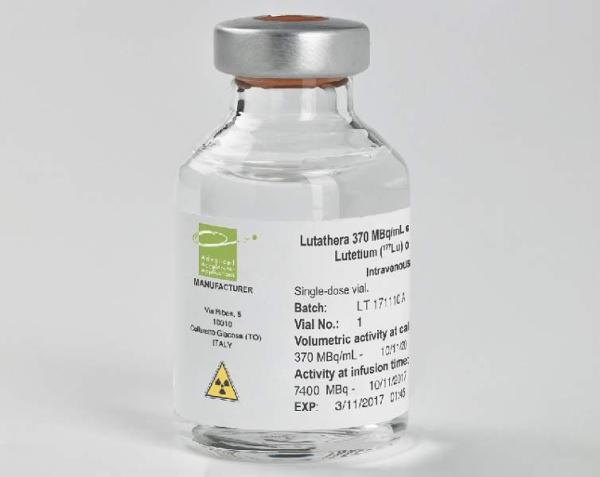Lutetium Lu 177 Dotatate Dosage
Medically reviewed by Drugs.com. Last updated on May 14, 2025.
Applies to the following strengths: 370 MBq/mL
Usual Adult Dose for:
Usual Pediatric Dose for:
Additional dosage information:
Usual Adult Dose for Neuroendocrine Carcinoma
Intravenous infusion: 7.4 GBq (200 mCi) every 8 weeks for a total of 4 doses
Premedication and Concomitant Medications:
Somatostatin Analogs:
- Discontinue long-acting somatostatin analogs (e.g., long-acting octreotide) for at least 4 weeks prior to initiating this drug. Administer short-acting octreotide as needed; discontinue at least 24 hours prior to initiating this drug.
- During treatment: Administer long-acting octreotide 30 mg intramuscularly 4 to 24 hours after each dose of this drug. Do not administer long-acting octreotide within 4 weeks of each subsequent dose. Short-acting octreotide may be given for symptomatic management during treatment with this drug, but must be withheld for at least 24 hours before each dose of this drug.
- Following treatment: Continue long-acting octreotide 30 mg intramuscularly every 4 weeks after completing this drug until disease progression or for up to 18 months following treatment initiation.
Antiemetic:
- Administer antiemetics 30 minutes before the recommended amino acid solution.
Amino Acid Solution:
- Initiate an intravenous amino acid solution containing L-lysine and L-arginine 30 minutes before administering this drug.
- Use a three-way valve to administer amino acids using the same venous access as this drug or administer amino acids through a separate venous access in the patient's other arm.
- Continue the infusion during, and for at least 3 hours after infusion of this drug.
- Do not decrease the dose of the amino acid solution if the dose of this drug is reduced.
Comments:
- Dose modifications due to adverse reactions are provided in the dose adjustment section.
- Radiation Dosimetry: The maximum penetration in tissue is 2.2 mm and the mean penetration is 0.67 mm.
- The mean and standard deviation of the estimated radiation absorbed for patients receiving this drug are shown in the appropriate tables within the package insert.
Use: For the treatment of adult and pediatric patients 12 years and older with somatostatin receptor-positive gastroenteropancreatic neuroendocrine tumors (GEP-NETs), including foregut, midgut, and hindgut neuroendocrine tumors.
Usual Pediatric Dose for Neuroendocrine Carcinoma
12 years and older:
Intravenous infusion: 7.4 GBq (200 mCi) every 8 weeks for a total of 4 doses
Premedication and Concomitant Medications:
Somatostatin Analogs:
- Discontinue long-acting somatostatin analogs (e.g., long-acting octreotide) for at least 4 weeks prior to initiating this drug. Administer short-acting octreotide as needed; discontinue at least 24 hours prior to initiating this drug.
- During treatment: Administer long-acting octreotide 30 mg intramuscularly 4 to 24 hours after each dose of this drug. Do not administer long-acting octreotide within 4 weeks of each subsequent dose. Short-acting octreotide may be given for symptomatic management during treatment with this drug but, must be withheld for at least 24 hours before each dose of this drug.
- Following treatment: Continue long-acting octreotide 30 mg intramuscularly every 4 weeks after completing this drug until disease progression or for up to 18 months following treatment initiation.
Antiemetic:
- Administer antiemetics 30 minutes before the recommended amino acid solution.
Amino Acid Solution:
- Initiate an intravenous amino acid solution containing L-lysine and L-arginine 30 minutes before administering this drug.
- Use a three-way valve to administer amino acids using the same venous access as this drug or administer amino acids through a separate venous access in the patient's other arm.
- Continue the infusion during, and for at least 3 hours after infusion of this drug.
- Do not decrease the dose of the amino acid solution if the dose of this drug is reduced.
Comments:
- Dose modifications due to adverse reactions are provided in the dose adjustment section.
- Radiation Dosimetry: The maximum penetration in tissue is 2.2 mm and the mean penetration is 0.67 mm.
- The mean and standard deviation of the estimated radiation absorbed for patients receiving this drug are shown in the appropriate tables within the package insert.
Use: For the treatment of adult and pediatric patients 12 years and older with somatostatin receptor-positive gastroenteropancreatic neuroendocrine tumors (GEP-NETs), including foregut, midgut, and hindgut neuroendocrine tumors.
Renal Dose Adjustments
Mild to moderate renal dysfunction:
- No adjustment recommended.
- Patients may be at greater risk of toxicity; frequent assessments of renal function should be performed.
Severe renal dysfunction (CrCl less than 30 mL/min) and ESRD: Safety has not been studied.
If renal dysfunction develops during therapy:
If creatinine clearance is less than 40 mL/min, 40% increase, or 40% decrease in baseline serum creatinine:
- Withhold dose until complete or partial resolution.
- Resume this drug at 3.7 GBq (100 mCi) in patients with complete resolution.
- If reduced dose does not result in renal toxicity, administer this drug at 7.4 GBq (200 mCi) for next dose.
- Permanently discontinue this drug for renal toxicity requiring a treatment delay of 16 weeks or longer.
- Recurrent renal toxicity: Permanently discontinue this drug.
Liver Dose Adjustments
Mild to moderate liver dysfunction: No adjustment recommended.
Severe liver dysfunction (total bilirubin 3 times more the upper limit of normal and any AST): Safety has not been study.
If liver dysfunction develops during therapy:
If bilirubinemia is greater than 3 times the upper limit of normal (Grades 3 or 4) or hypoalbuminemia is less than 30 g/L with a decreased prothrombin ratio less than 70%:
- Withhold dose until complete or partial resolution.
- Resume this drug at 3.7 GBq (100 mCi) in patients with complete resolution.
- If reduced dose does not result in hepatotoxicity, administer this drug at 7.4 GBq (200 mCi) for next dose.
- Permanently discontinue this drug for hepatotoxicity requiring a treatment delay of 16 weeks or longer.
- Recurrent hepatotoxicity: Permanently discontinue this drug.
Dose Adjustments
Thrombocytopenia Grade 2, 3 or 4:
- Withhold dose until complete or partial resolution (Grade 0 to 1).
- Resume this drug at 3.7 GBq (100 mCi) in patients with complete or partial resolution.
- If reduced dose does not result in Grade 2, 3 or 4 thrombocytopenia toxicity, administer this drug at 7.4 GBq (200 mCi) for next dose.
- Permanently discontinue this drug for Grade 2 or higher toxicity requiring a treatment delay of 16 weeks or longer.
- Recurrent toxicity Grade 2, 3 or 4: Permanently discontinue this drug.
Anemia and Neutropenia Grade 3 or 4 or Any other Adverse Reactions, Grade 3 or 4:
- Withhold dose until complete or partial resolution: Anemia and Neutropenia (Grade 0, 1, or 2).
Any other Adverse Reaction (Grade 0 to 2)
- Resume this drug at 3.7 GBq (100 mCi) in patients with complete or partial resolution.
- If reduced dose does not result in Grade 3 or 4 toxicity, administer this drug at 7.4 GBq (200 mCi) for next dose.
- Permanently discontinue this drug for Grade 3 or higher toxicity requiring a treatment delay of 16 weeks or longer.
- Recurrent Grade 3 or 4: Permanently discontinue this drug.
Precautions
Safety and efficacy have not been established in patients younger than 18 years.
Consult WARNINGS section for additional precautions.
Dialysis
Data not available
Other Comments
Administration advice:
- Handle with appropriate safety measures to minimize radiation exposure.
- Use aseptic technique, waterproof gloves, tongs, and radiation shielding when administering this drug.
- This drug should be used by or under the control of physicians qualified by specific training and experience in the safe use and handling of radiopharmaceuticals, and whose experience and training have been approved by the appropriate governmental agency authorized to license the use of radiopharmaceuticals.
- Prior to administration, flush the catheter used for the administration of this drug with at least 10 mL of 0.9% Sodium Chloride Injection to ensure patency and to minimize the risk of extravasation. Manage cases of extravasation as per institutional guidelines.
- Do not administer as an intravenous bolus.
- During the infusion, ensure that the level of solution in the vial remains constant.
- The manufacturer product information should be consulted.
Storage requirements:
- Store below 25C (77F), Do not freeze.
- Store in the original packaging to protect from ionizing radiation.
- The shelf life is 72 hours from the date and time of calibration. Discard appropriately at 72 hours.
Reconstitution/preparation techniques:
- Do not inject directly into any other intravenous solution.
- Confirm the amount of radioactivity of this drug in the radiopharmaceutical vial with an appropriate dose calibrator prior to and after administration.
- Inspect the product visually for particulate matter and discoloration prior to administration under a shielded screen. Discard vial if particulates or discoloration are present.
- Dispose of any unused medicinal product or waste material in accordance with local and federal laws.
- The manufacturer product information should be consulted.
Patient advice:
- Patients should contact their healthcare provider for any signs or symptoms of myelosuppression or infection, such as fever, chills, dizziness, shortness of breath, or increased bleeding or bruising.
- There is a potential for secondary cancers, including myelodysplastic syndrome and acute leukemia.
- Patients should hydrate and urinate frequently during and after administration of this drug.
- Periodic laboratory tests to monitor for hepatotoxicity are recommended.
- Patients should contact their health care provider for signs or symptoms that may occur following tumor-hormone release, including severe flushing, diarrhea, bronchospasm, and hypotension.
- Advise patients and/or caregivers that this drug may cause hypersensitivity reactions, including angioedema, and to seek immediate medical attention for signs or symptoms of hypersensitivity.
- Advise pregnant women and males and females of reproductive potential of the potential risk to a fetus. Advise females to inform their healthcare provider of a known or suspected pregnancy.
- Advise females of reproductive potential to use effective contraception during treatment with this drug and for 7 months after the last dose.
- Advise male patients with female partners of reproductive potential to use effective contraception during treatment and for 4 months after the last dose.
- Advise females not to breastfeed during treatment and for 2.5 months after the last dose.
- Advise female and male patients that this drug may impair fertility.
More about lutetium lu 177 dotatate
- Check interactions
- Compare alternatives
- Reviews (1)
- Side effects
- During pregnancy
- Drug class: therapeutic radiopharmaceuticals
- Breastfeeding
- En español
Patient resources
Other brands
Professional resources
Other brands
Related treatment guides
See also:
Further information
Always consult your healthcare provider to ensure the information displayed on this page applies to your personal circumstances.


